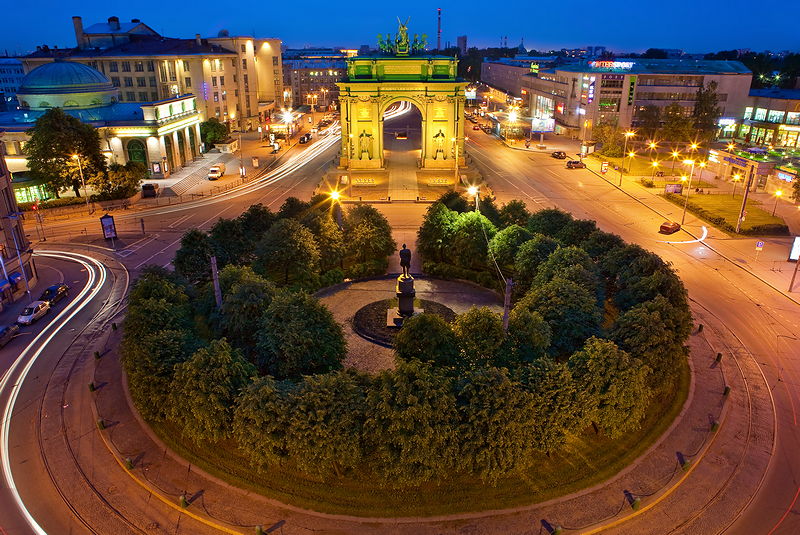Ploshchad Stachek (Square of Strikes)
Stachek Square is well known for the Narva Triumphal Arch dedicated to the victory of the Russian nation in the Patriotic War of 1812, and as the location where peaceful demonstrators were shot on their way to the Tsar Nicolas II with requests for reform in 1905. Less known is that in 1920, Stachek Square was seen as a possible new social center for the city as opposed to the old regime of Palace Square. There were several notable buildings built in the style of constructivism. However, in the 1930s plans changed and Moscovskaya Square was chosen as the new center of the city.

The history of Stachek Square starts in the early 18th century when the highway from Narva and Revel (now Tallinn) to St. Petersburg was constructed. In 1814, the arch solemnly greeted the troops who participated in the War of 1812 and having reached Paris in the campaigns of 1813 and 1814. The wooden triumphal arch was replaced with stone and covered with sheets of copper, a project undertaken by Russian architect Vasily Stasov in the years 1827-1834.
At the end of 19th century, the area was the south-western boundary of the city and many workers lived in the barracks here. In January 1905, suffering under tyranny from officials, tens of thousands of workers from in and around St. Petersburg formed several columns intending to get to the Winter Palace to present their demands to the tsar. These workers, who were marching from the Putilov Plant, were met at the Narva Arch by imperial soldiers and shot. Around 40 of the workers were killed. These bloody events served as an impetus for the beginning of the First Russian Revolution. To this day near the arch you can see the red-colored pavement.
In memory of these events, the square was renamed Stachek ("Strike") Square in 1923. At the same time, the area was being reconstructed as the old barracks were replaced by several constructivist buildings. The plan to create a new urban center was designed by renowned Soviet architect Ivan Fomin. The Gorky Palace of Culture was built by the architects Alexander Gegello and David Krichevsky while the department store of the Moscow-Narva district was constructed by four other architects. However, by the 1930s the neo-classical Stalinist fashion became the dominant style, and its most important enforcer, Noi Trotsky, built a few houses on the square. In 1955, the Stalinist-style "Narvskaya" metro station was one of the first stations to open in the city.
These days the square is a layover point for those travelling to the southern suburbs of St. Petersburg such as Dachnoe, Pine Meadow, Strelna, and Red Village. Tourists mainly come here to visit the Narva Triumphal Arch located near the picturesque Ekateringof Park.
| Metro stations: | Narvskaya |
|---|---|
| Directions: | Exit Narvskaya metro station |
| What's here? | Narva Triumphal Arch |
| What's nearby? | Ekateringof Park, Prospekt Stachek |

